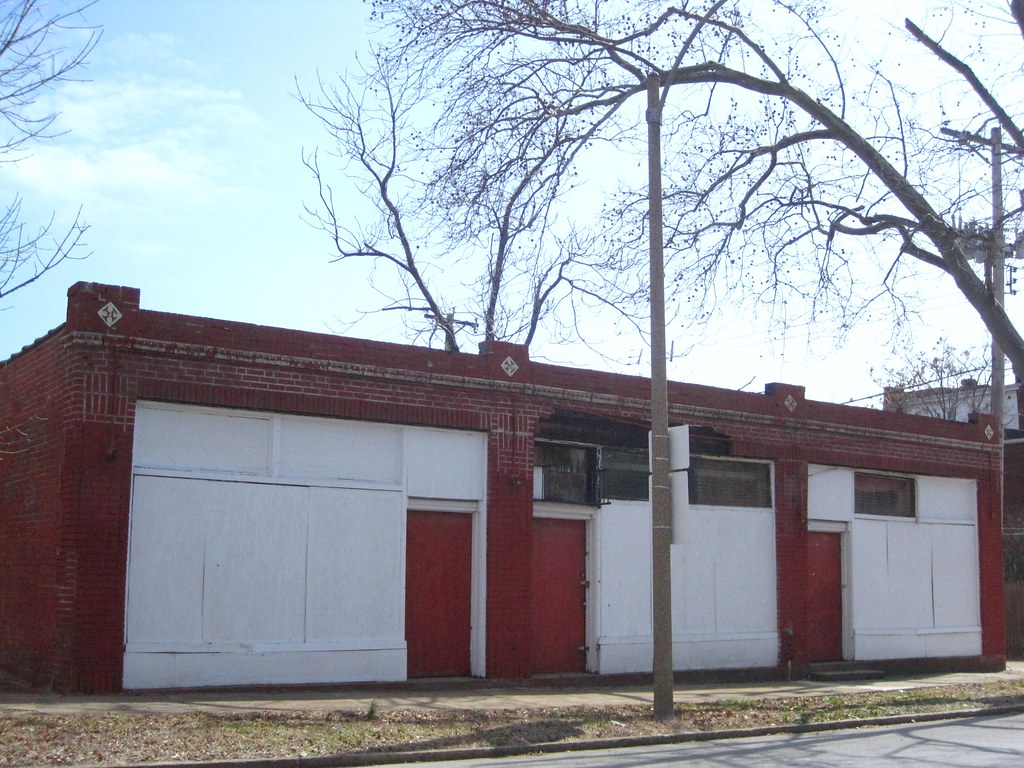 UPDATE Monday, March 22 at 7:21 p.m.: The Preservation Board voted to uphold staff denials for both 414-18 N. Boyle and 6102 Michigan.
UPDATE Monday, March 22 at 7:21 p.m.: The Preservation Board voted to uphold staff denials for both 414-18 N. Boyle and 6102 Michigan.The little storefront row at 414-18 N. Boyle in the Central West End is one of a few commercial buildings left in the area once known as "Gaslight Square" -- but not for much longer. Owner Core Holdings LLC applied for a demolition permit in January. The Cultural Resources Office denied the permit, and the owner has appealed to the city's Preservation Board. The appeal is on the agenda for the Monday, March 22 meeting of the Preservation Board. The proposed reuse for the site? None.
At first glance, the row seems easily forgettable and somewhat damaged. Yet the little row is both a reminder of the past streetcar-fueled development of the Central West End and an asset for the surrounding area, which is full of rehabbed existing buildings and the new houses that now occupy Olive Street to the east. The neighborhood could use a few retail outlets. Anyone who has been to the strip around the Gaslight Theater one block south and around the bend knows that the neighborhood can support commerce.
 The little row was built behind a large house that once stood facing Westminster. The first section was a small one-room brick carpenter's shop built at the alley in 1910; the row expanded at some point in the next decade. The Maryland Avenue streetcar line went north along Boyle to connect to the Olive Street line; this little backyard was too valuable not to build up. In fact, the owner of the house to the south built a similar row at 408-10-12 N. Boyle across the alley -- now long gone.
The little row was built behind a large house that once stood facing Westminster. The first section was a small one-room brick carpenter's shop built at the alley in 1910; the row expanded at some point in the next decade. The Maryland Avenue streetcar line went north along Boyle to connect to the Olive Street line; this little backyard was too valuable not to build up. In fact, the owner of the house to the south built a similar row at 408-10-12 N. Boyle across the alley -- now long gone.Sculptor Sheila Burlingame (1895-1969), whose works include the sculpture on the front of Nagle and Dunn's St. Mark's Episcopal Church (1939) at 4714 Clifton, maintained a studio in the storefront at 412 N. Boyle. The existing row's tenants were less glamorous but also indicative of a vibrant urban fabric. The 1940 city directory shows Jacob Shaikewitz offering shoe repair at 414, barber Frand Bond at 416 and Georgia Gunn's beauty shop at 418. By 1959, at the onset of the Gaslight Square heyday, 414 N. Boyle was home of the Handy Shopperdeli, 416 housed the Boyle Avenue Barber Shop (Frank Bond still around?) and 418 was now Dorothy's Beauty Shop. The row would be vacant within a few years, and later used as a church before going vacant again.
It would not take much to bring back the commercial bustle to this stretch of Boyle. The streetcar is gone, but residential density remains. Yet the demolition of the Olive Street commercial buildings renders remaining storefronts as precious resources. Judging from recent decisions, the Preservation Board is unlikely to approve a permit for an out-of-town owner with no redevelopment plan. Common sense suggests a different course of action: Preservation Board denial and a for-sale sign.
Also on Monday's Preservation Board agenda is the appeal of a Cultural Resources denial of a demolition permit for 6102 Michigan Avenue in the Central Carondelet Historic District. I'd be very surprised if any Board member votes to overturn the appeal.
The Preservation Board meets at 4:00 p.m. Monday on the 12th floor of the building at 1015 Locust Street downtown. Written comments may be submitted to the Board via Adona Buford, Secretary, at BufordA@stlouiscity.com.





2 comments:
Thank you, Michael, for providing such interesting information on one of my favorite neighborhood buildings. I plan to be at the pres. board meeting to defend this scrappy survivor.
"It would not take much to bring back the commercial bustle to this stretch of Boyle." Yeah, just money and tenants . . .
Post a Comment